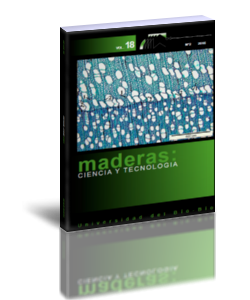Hygromechanical strains during the drying of Eucalyptus nitens boards
Keywords:
Deflection, deformation, drying stresses, mechano-sorption, wood drying.Abstract
Collapse and drying stresses are currently induced during the drying of Eucalyptus nitens in solid wood products. The purpose of this study was to investigate these drying stresses by measuring hygromechanical strains during the drying of Eucalyptus nitens boards.
Small samples of Eucalyptus nitens wood were oriented in the radial and tangential directions and tested to determine the hygromechanical strains during the drying process. This experimental work consisted of cantilevered bending tests conducted under variable relative humidity conditions. Tests were performed in a conditioning chamber at 30 °C with an equilibrium moisture content ranging from 22 to 12% under four levels of stress: 0, 10, 20 and 30% of the rupture load. The strains were determined using strain gauges, and the total deflection was measured with a linear variable differential transformer.
The results show that in hygromechanical strains during the drying of Eucalyptus nitens, both the surface deformation and mechano-sorption strain were found to be proportional to the applied stress and reached their maximum values in the tangential direction. The total deflection increased 0,18 mm/mm with a surface deformation of 0,20 mm/mm, and the mechano-sorptive strain provides a greater contribution with a value of 0,11 mm/mm, thus corresponding to 59% of the total deformation. In attempts to improve the drying schedules of Eucalyptus nitens to develop solid wood products, mechano-sorptive behavior may be applied to relieve collapse and drying stress.
Downloads
References
Ananías, R.A.; Sepúlveda, V.; Pérez, N.; Leandro, L.; Salvo, L.; Salinas, C.; Cloutier, A.; Elustondo, D.M. 2014. Collapse of Eucalyptus nitens wood after drying depending on the radial location within the stem. Drying Technology 32(14):1699-1705.
Armstrong, L. D.; Kingston, R. S. T.1962. The effect of moisture content changes on the deformation of wood under stress. Australian Journal of Applied Science 13(4):257-276.
Blakemore, P. 2011. Internal checking during Eucalypts processing. Ch 12, in Delamination in wood, wood products and wood based composites, Ed. B. Bucur. Springer, N. York. 237-254.
Clair, B. 2012. Evidence that release of internal stress contributes to drying strains of wood. Holzforschung 66:349-353.
Chen, T.; Gu, L. 2006. Development of elastic strain and mechano-sorptive strain during conditioning of Eucalyptus camaldulensis lumber in batch kiln. Maderas. Ciencia y tecnología 8(1):49-56.
Erikson, R. 1994. The effect of drying temperature on the mechano-sorptive behavior of red oak lumber. Drying Technology 12(8):1943-1961.
Fu, Z; Cai, Y.; Zhao, J.; Huan, S. 2013. The effect of shrinkage anisotropy on tangential rheological properties of Asian White birch disks. Bioresources 8(4):5235-5243.
Hassani, M; Wittel, F.; Hering, S.; Herrmann, H. 2015. Rheological model for wood. Comput Methods Appl Mech Engrg 283:1032-1060.
Hunt, D.G.; Shelton, C.F. 1988. Longitudinal moisture-shrinkage coefficients of softwood at the mechano-sorptive creep limit. Wood Science and Technology 22:199-210.
Kang, W.; Lee, N.; Jung, H. 2004. Simple analytical methods to predict one – and two – dimensional drying stresses and deformations in lumber. Wood Science and Technology 38:417-428.
Keey, R.; Langrish, T.; Walker, J. 2000. Kiln-drying of lumber. Springer-Verlag, Berlin, pp. 65-181.
Langrish, T. A. G. 2013. Comparing continuous and cyclic drying schedules for processing hardwood timber: The importance of mechanosorptive strain. Drying Technology 31:1091-1098.
Lazarescu C.; Avramidis, S.; Oliveira, L. 2009. Modeling shrinkage response to tensile stresses in wood drying: I. Shrinkage moisture interaction in stress-free specimens. Drying Technology 27(11):1183-1191.
Mårtensson, A. 1994. Mechano-sorptive effects in wooden material. Wood Science and Technology 28:437-449.
Moutee, M.; Fafard, M.; Fortin, Y.; Laghdir, A. 2005. Modeling the creep of wood cantilever loaded at free end during drying. Wood Fiber and Science 37(3):521-534.
Moutee, M.; Fortin, Y.; Laghdir, A.; Fafard, M. 2010. Cantilever experimental setup for rheological parameter identification in relation to wood drying. Wood Science and Technology 44:31-49.
Pang, S. 2000. Modelling of stress development during drying and relief during steaming in Pinus radiata lumber. Drying Technology 18(8):1677-1696.
Pang, S. 2002. Investigation of effects of wood variability and rheological properties on lumber drying: application of mathematical models. Chemical Engineering Journal 86:103-110.
Salinas, C.; Chavez, C.; Ananías, R.; Elustondo, D. 2015. Unidimensional simulation of drying stress in radiata pine wood. Drying Technology 33(8): 996-1005.
Segovia, F.; Blanchet, P.; Laghdir, A.; Cloutier, A. 2013. Mechanical behavior of sugar maple in cantilever bending under constant and variable relative humidity conditions. International Wood Products Journal 4:225-231.
Sepúlveda, V.; Pérez, N.; Salinas, C., Salvo, L.; Elustondo, D.; Ananías, R.A. 2015. Development of moisture and strain profiles during pre-drying of Eucalyptus nitens. Drying Technology 34(4): 428-436.

































